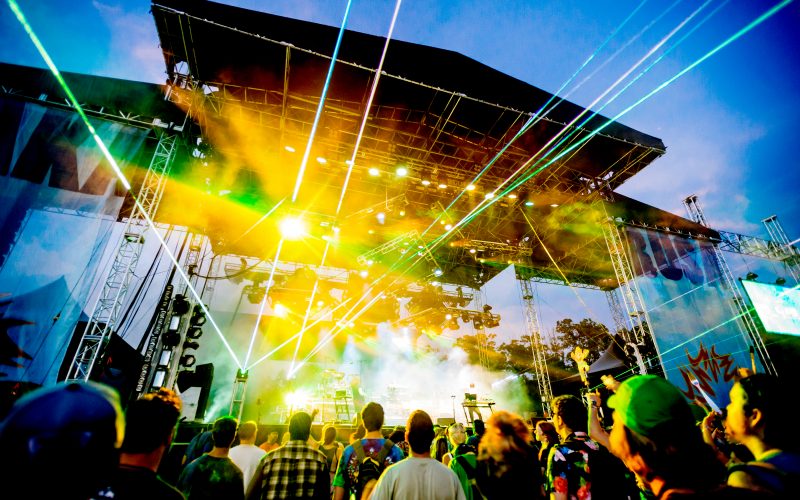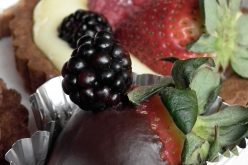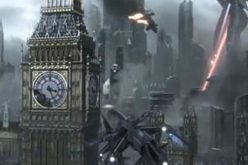 By Nick Brothers
By Nick Brothers
After the sun set on Mulberry mountain Friday night, The Flaming Lips took the stage. I was one person in a sea of 19,000, and it was hard to ignore the good vibes everyone was putting off.
The Lips are known for their theatrical performances, and tonight would be no different.
Wayne Coyne, the lead singer, looked like he had his insides exposed. He wore a skin-tight suit that looked like a biology chart of the human body’s muscular system. He also wore a courtesy silvery glitter pom-pom at his crotch. Behind him stood a 15-foot-tall animated rainbow wall that radiated into infinity, and above him hung what seemed like hundreds of rope lights that mimicked rainfall. The set up alone would have been satisfying.
After rolling through their first song “Race For The Prize,” Coyne stopped the music and brought a young couple on stage. He introduced the two as Chris and Paige. They wanted to get married in front of the sea of 19,000 citizens of the technicolor tent city. Coyne happily obliged, whether he was licensed or not. He had them say their vows, and had them say their “I dos” into the microphone.
“It’s the power of love under this universe,” he said, his arms raised high. “With it, I pronounce you man and wife tonight!”
With that, glitter exploded across the stage and the band slid perfectly into their classic 1993 hit, “She Don’t Use Jelly.” Frankly, that was crazy.
You see, to many Wakarusians, when you ask them about what the festival means to them, there always seemed to be two words that came up: love and community. After watching Chris and Paige pronounce their love at this crazy, unpredictable music festival for all to see and celebrate with, those two words sunk in.

Staff Photo Stephen Ironside
Wayne Coyne, The Flaming Lips vocalist, pronounces Chris and Paige man and wife during The Flaming Lips concert Friday night, June 6.
The scenery on the way to Mulberry mountain was gorgeous. Sometimes breathtaking.
The weekend was my greenhorn Wakarusa, so even the drive through the wilds of Madison County was new to me. The giant, lush, sage-green rolling hills made for quite the beautiful driving distraction and the tree archway highway made it seem like I was entering some kind of fairyland. I had virtually no traffic, and — at least in my experience — getting inside the festival and finding parking couldn’t have been easier.
When I got there, the first press conference was going on inside the campground’s “convention center,” — an oasis of air conditioned, roofed-and-walled building, the only one I entered the entire weekend — which was used for staff meals and a space for media to work. Thursday’s press conference had Vintage Trouble and Nahko and the Medicine for the People answering questions: The two groups had some insightful things to say. Most press asked about festival vibes and where the artists get their lyrical inspiration, but the two bands dropped some really insightful bombs a couple times.
The best was when Vintage Trouble guitarist Nalle Colt answered what music festivals meant to him.
“I think these festivals embody two things, y’know, music and community,” he said. “I think that’s something we all desperately need.”
It was short and sweet, and it’s something I heard talked about all weekend long. Wakarusa means much more than the preconceived let’s-get-wasted-loud-music-stank-fest. Many people, they believe in this festival. And honestly, maybe I do, too.
IMMERSED
I was lone wolf the majority of Thursday, and I could feel the love. I never felt unsafe or in danger. If anything, I felt like I was a part of something. Maybe it was the mountainous Arkansas setting, but everyone I crossed paths with was so friendly and engaging. I could have had a meaningful conversation with anyone there. Sure, some would be crazier than others, but Wakarusa brings out people’s passions. I can’t quite place it, but there is absolutely a great vibe to Wakarusa.
The vibe came from the festival’s people. During my travels on Mulberry mountain, I came across a few folks that showed me some hospitality.
I met a man at Dr. Dog — Jason from St. Louis, Mo. This was common: To strike up a conversation with whoever was next to you at concerts. I didn’t have a recorder running when I asked him what Wakarusa meant to him. He spoke about how the festival embodied love and community and how it made for a safe environment for him to run solo.
“Waka is love and expanding your consciousness,” he said.
He was in between jobs; he said he was happy to leave his previous employer. He told me about how I needed to check out the band Big Nazo, and we talked about how he had dreams to travel out West soon. Near the end of Dr. Dog’s set, I wished him well and we parted ways. I saw him again for a brief second in the crowd at Edward Sharpe and the Magnetic Zeroes.
While checking out Foley’s Van’s Wakarusa performance (which was super-bad-ass) a man named Bruce from Fayetteville struck up a conversation with me by asking if I had some water that I could splash in his cup of straight whiskey. He offered me a pull of whiskey, saying “It’ll put hair on your chest.”
After interviewing Adventure Club (you can read the interview on page 14 in print, or online here) I met PJ from Jonesboro before the Adventure Club show started. He noticed I was wearing my sound-sensitive light-up shirt that looked like the green, yellow and red stereo volume levels. He wanted me to make sure I was going to turn on my light-up t-shirt. We talked about how different Fayetteville and Jonesboro are, and the entertainment scene there. He told me about the work he does as essentially a person who studies sleep patterns. I was fascinated, but he said he’d bore me to death. Once the music started, the crowd shifted and I moved on.
STUDIES
At Wakarusa, I could tell that some people bring an alter ego to the festival. They dress a little looser, they dress a little ridiculous, and they wear a lot of neon and face paint. That’s the beauty of festivals, I think. You could be a 9-to-5 business casual nurse, corporate manager, lawyer or teacher — but at this festival, you’re someone else entirely. In a way, it’s as if people became their childhood dreams for a weekend. I saw mermaids, disco kings and queens, an angel smoking a cigarette, countless fairies, a 10-foot-tall Gumby, a topless shaman/priestess woman, several people dressed as mushrooms, gypsyesque cowgirls and a couple women in only body paint above the waist. The cost of a ticket could redeem itself just in the amount of people watching.

Staff Photo Stephen Ironside
Dressed up festival attendees walk the grounds in stilts. Costumes were plenty at Wakarusa.
The best part is, there’s no average Wakarusian. The crowd is so diverse. I saw tank-top bros, dreadlock rastas, big-bearded fellas, glitter-bombed fairy men (one referred to himself as Glamour Hammer), a lot of Afros and shoulder-length hair, otherwise normal-looking men in tribal shirts and the standard t-shirt, baseball cap, and jean shorts.
Women were something else, and despite the conditions, they still managed to look gorgeous. They wore tank tops, tribal-printed cardigans, bikinis and push up bras, wide-brimmed sun hats, fedoras, galaxy-printed leggings, and technicolor robes and skirts.
If Wakarusa had a fashion magazine, that shit would be crazy.
There was also this reoccurring young couple stereotype — and I can only presume — who looked like they weren’t having a good time, but they were always stylish.
One of my favorite groups I saw was a very clean-cut older couple who had brought their older son or daughter with them, who brought their boyfriend or girlfriend. They stuck out, but then again, they fit in with everyone else. It was just great to see every kind of person there.
During some of the biggest sets, namely Sound Tribe Sector 9 (STS9) and The String Cheese Incident’s four-hour set, I roved the crowds. There appeared to be a hierarchy of fans and festival goers from the stage to the back fence.
First of all you have to understand this: At nighttime, Wakarusa becomes a different festival. You see, it’s two-faced. During the day, the stages feature Americana, folk, rock and funk. The satellite stage does feature EDM throughout the day. But once the sun goes down and the late headliner ends at about midnight, Wakarusa becomes a full on for-lack-of-a-better-word hippie night club. People dress in light-up clothing and neon paint, and glow sticks become abundant. These people are ready to rage.

Staff Photo Stephen Ironside
Women could be seen hula hoop dancing all throughout the Main Stage area during the biggest shows at the festival.
At the back of every crowd sat the Wakarusa highway. Just like the ones meant for vehicles, you have to merge onto traffic and exit in a way that doesn’t surprise the people behind you. So at the back of the bigger shows, there is a constant flow of people moving about, making this area very busy. The hard part was the highway wound through dozens of people on picinic blankets, laying low during the spectacle on the stage.
At the back of the crowd, other than the the picnic blanketers, were the light performers. Hula hoops, especially light-up ones, were immensely popular with the ladies at the festival. They could be seen dancing with them all around the crowd. The male equivalent was these light-up balls of light attached to a wire, that the men would swing around like nunchucks.
As you went deeper into the crowd, naturally, the amount of apathy for the band playing decreased.

Staff Photo Stephen Ironside
Fire dancers could be spotted all over the festival during the nighttime.
There were also more performers. The folks with the Astral Gypsies performance group brought out everything they had at every main-stage show. They had 20-foot-tall puppets that sat on their backs that could be seen swimming through the crowd, looking like aliens and cartoon characters. There was also a neon light-up octopus that was operated by eight people that glided over the crowd from the very back to the front of the crowd. It was a spectacle.
PEACE, LOVE AND CHOMPDOWN
Chompdown, in a simple sense, is a free plate of eggs, bacon, sausage, and whatever is available at the RV campsite. It starts at 9 a.m., it’s a word of mouth event, and the day and time depends on when Dirtfoot plays at the festival.
Once you get there, you can find Laura “RedBobb” Bryan singing, “If you want to be at the front of the line, you bring bacon next time!” or Andrea Rizzo supervising the army of 40 volunteer chefs and helpers feeding the hundreds of hungry festivalgoers. On the long picinic table there’s a myriad of dishes — bowls of scrambled eggs with onions, tomatoes and peppers, a giant plate of grilled assorted breakfast meats, sliced bread and different edible odds and ends.
During the breakfast, those there get treated to the sounds of Dirtfoot, the gypsy-punk-country-grumble-boogie band from Louisiana. When Chompdown started in 2007, organizers contacted the band through Myspace to do an acoustic set. Since then, they’ve gone electric, and they still play at it for free. (For an interview with the grizzly dudes of Dirtfoot, check out the Q&A here.)

Staff Photo Nick Brothers
Festival goers line up for the free annual unofficial breakfast, The Chompdown. Started in 2007 when Wakarusa was held in Lawerence, Kansas, Chompdown operates completely through volunteers and food donations.
Everything about the Chompdown rests on the generosity of strangers. All of the food is donated, no one is paid, and no one takes money. The Chompdown was built on the principle of “pay it forward” by the late beloved Jon Cabrera in 2007, who died of Hodgkins Lymphoma in July 2009.
On a trip to go to a rainbow gathering, essentially a peace festival, in New York, Cabrera and his friend John Gallup had run out of food. They managed to find an older couple with a KU flag, and they took them in and fed them. They refused any repayment under the condition that the two would do the same to someone else in the future. Chompdown, which began as an online forum gathering, eventually became that future where Cabrera could give back and involve others along the way. The mission survives through Bryan, Rizzo, Mindy Whiting and Coree Unruh, who all except Bryan knew him personally.
“It’s gotten to a point where the founding group sits back and orchestrates. Our work is not as manual as it was before,” Unruh said. “It’s started to feed itself. People want to be involved, and I feel like it serves a purpose when we get together to take care of each other.”
Wakarusa and Pipeline Productions have been supportive every year, and they allow for the organizers to reserve the space for the event.
It was a blast getting to talk with the ladies of Chompdown, and I’d recommend anyone one planning on going to Wakarusa next year or Harvest Festival in October, it’s a great thing to be a part of. As J Bratlie of Dirtfoot calls it, it’s a “humanity booster shot.”
TAKEAWAYS
Overall, the festival was a lot of fun, even if it got to be very wet. It’s true what they say about “It’s a marathon, not a sprint.” I found myself wanting to do everything all at once and see every band I could see. Luckily, I had a friend I could hang out with at the festival, and he made time to chill — something I didn’t plan on. Doing so helped me have the energy to take on the rest of the day — and night. Bringing ear plugs is a good idea if you plan on sleeping through the late night sets.
There was also definitely some drug use going on at the festival. However, I think Michael Kang of The String Cheese Incident addressed it the best way at the Friday press conference when asked about drug use at their shows.

Staff Photo Stephen Ironside
Bill Nershi, String Cheese Incident guitarist, jams along with the rest of the band during their four-hour set Saturday night, June 7.
“We’re all adults here. I think we’re all responsible for our own expanding of our consciousness,” he said. “I’m personally all for people doing it responsibly, and doing it in a manner that is loving.”
My favorite shows?
Well, I’ll tell ya.
My first interview was with Paul Janeway of St. Paul & The Broken Bones, and they were my first show on Friday. (To read my quick interview with him, check it out here.) They were amazing. If you like the Alabama Shakes or fun, funky soul music, you need to check them out.
Murder By Death. Look out for these guys. Imagine Johnny Cash playing in an indie-rock band. That’s kind of what these guys sound like. Tons of energy.
J Roddy Walston and the Business straight brought the heat. I loved their two sets. (I also got an awesome interview with them, which you can read on page 18 in print and online here.)
The Black Cadillacs are a bunch of young men in a blues-indie rock outfit, managing to keep a wilting genre alive. (My interview with them can be found here.)

Staff Photo Stephen Ironside
Alex Ebert, a.k.a. Edward Sharpe, joins the crowd in his performance of “Man On Fire,” Saturday, June 7.
Edward Sharpe and the Magnetic Zeroes were a lot of fun, but the recent departure of singer Jade Castrinos made for a poignant show. The highlight was when Alex Ebert, a.k.a. Edward Sharpe, brought up a man from the crowd during the part in “Home” where he and Jade tell a story to each other. So he had this man tell a story. He talked about how seeing Edward Sharpe at Wakarusa two years ago changed his life. He loved the festival so much, he quit his job and decided to blog reviews about festivals throughout the U.S. He managed to slide in a small sales pitch, and it kinda killed the mood for a second, but he looked at Ebert and said, “You just changed my life again,” and got to dance along with the band for the rest of the song.
String Cheese Incident might be one of the most creative bands out there. Watching them perform was like listening to a circus of sound. They were genre-less. They made music with nearly every instrument you could, and they made it all work. The best word to describe it would be marvelous.
DEPARTURE
I left the festival Sunday afternoon. There was rain throughout the festival, but Sunday was the worst. I had made plans to go up in the Ferris wheel and hike to the waterfall, but it was just miserable, and the hike would have been a slippery, muddy joke. So I packed up my tent in the rain, getting soaked. I had a perfect little set up in the media campsite on the inside of a corral of cars. Luckily I was able to squeeze through to the exit, and I was able to make my return home.
Honestly, this article, as long as it is, still barely covers all that transpired on Mulberry Mountain. All of it — the music, the people, Chompdown, the spectacle. It was a damn-fun time.
Even through the rain, there’s still something that Wayne Coyne said during the Flaming Lips show that stuck with me.
“I thought it might rain tonight. Then we’d just do this with the rain. That’s the beautiful fucked-up thing about life. You get what you get and you make it work.”
All I can say is yep.












